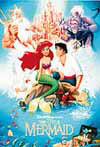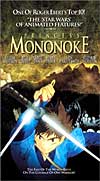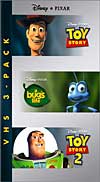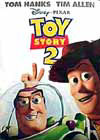Don Bluth:
In the late 70s, a Disney-trained animator named Don Bluth, who was an animator for Disney's Robin Hood (1973), The Rescuers (1977), Pete's Dragon (1977), The Many Adventures of Winnie the Pooh (1977), and The Fox and the Hound (1981) broke away and formed Don Bluth Productions with a group of disgruntled animators. His first notable non-Disney work was the animation sequence of Xanadu (1980). His first independent feature-length animation was The Secret of N.I.M.H. (1982), and his first big hit was the Spielberg-co-produced animation An American Tail (1986), starring coincidentally, a Russian mouse character named Fievel. At the time of its release, it was the highest grossing animated feature film.
The followup film, also Spielberg co-produced (without Bluth), was An American Tail: Fievel Goes West (1991), with James Stewart (in his last film before his death in 1997) as the voice of sheriff Wylie Burp. Other notable Bluth films included the Lucas/Spielberg production The Land Before Time (1988), All Dogs Go to Heaven (1989), Rock-A-Doodle (1992), Thumbelina (1994), The Pebble and the Penguin (1995), Anastasia (1997), and Titan A.E. (2000). [In 1983, Bluth was also noted for the development of the first laserdisc animated video-arcade games with Cinematronics, including Dragon's Liar and Space Ace. These titles fused the state of the art in arcade game technology and traditional cell animation.]
Disney's Animation Renaissance into the 80s:
In the 1960s, Walt Disney Studios re-emerged as a triumphant box-office moneymaker and producer of a variety of expensive-to-produce, animated and likable, wholesome live-action family features during the decade, including Mary Poppins (1964), a delightful musical fantasy combining animation and live-action sequences (winning the Best Special Effects Oscar), and featuring Best Actress-winning Julie Andrews in her screen debut as an energetic, eccentric nanny with magical powers in Edwardian London; also with Dick Van Dyke, and the songs "Supercalifragilisticexpialidocious" and the Oscar-winning "Chim-Chim Cher-ee."
 In the 60s through the 80s, Disney also released a second-tier of animated feature films, including the delightfully animated 101 Dalmatians (1961), The Sword in the Stone (1963), The Jungle Book (1967) - the last film that Walt personally worked on before his death in 1966, The Aristocats (1970), another live-action and animation feature Bedknobs and Broomsticks (1971) similar to Mary Poppins (1964), Robin Hood (1973), and The Rescuers (1977) (with Disney's first official animated sequel The Rescuers Down Under (1990)).
In the 60s through the 80s, Disney also released a second-tier of animated feature films, including the delightfully animated 101 Dalmatians (1961), The Sword in the Stone (1963), The Jungle Book (1967) - the last film that Walt personally worked on before his death in 1966, The Aristocats (1970), another live-action and animation feature Bedknobs and Broomsticks (1971) similar to Mary Poppins (1964), Robin Hood (1973), and The Rescuers (1977) (with Disney's first official animated sequel The Rescuers Down Under (1990)).
Throughout most of the 1980s, Disney struggled, and continued to release fairly mediocre animations, including the following:
- The Fox and the Hound (1981) - the first major effort by the "new generation" of Disney artists
- the costly-to-produce The Black Cauldron (1985)
- The Great Mouse Detective (1986)
- Oliver & Company (1988).
Although not a classic animated film, Disney's TRON (1982), the studio's first PG-rated film and the first feature film to imaginatively attempt to represent a computer-generated 'cyberspace' world, was the first live action film with over 20 minutes of computer animation. It told about gladatorial-style combat between two individuals within a computer's virtual reality world, including a race on light bikes. [The fictional cyberpunk book (the first of the cyberpunk literary genre) credited with coining the word 'cyberspace' (referring to the Internet) was William Gibson's Neuromancer in 1984. The book also referred to cyberspace as the Matrix. One of Gibson's short stories was later turned into the film Johnny Mnemonic (1995) with Keanu Reeves.] It was also the first film to popularize the idea of a computer or network in which one could experience virtual reality, and the first film to use the term 'hack' (the root of 'hacker' or 'hacking'), and to refer to the cyberuniverse as the 'matrix'. [Landmark composer Wendy (nee Walter) Carlos (who had collaborated earlier with Stanley Kubrick on A Clockwork Orange (1971) and The Shining (1980) - among others) provided a unique synthesized/orchestral score to accompany the pioneering, on-screen animation.] It was disqualified for a Best Visual Effects award because the old-fashioned Academy believed that it "cheated" by using a computer. (In fact, the film used a laborious, frame-by-frame process to produce its computer animation.) The concept of using computers to craft environments, rather than drawing them by hand, was considered inauthentic - until Cameron's computer-animated The Abyss (1989) won the Best Visual Effects Oscar.
A New Era of Disney Animation: The Late 80s and 90s
 Disney Studios soon returned to the quality of its heyday of animation from the 30s and 40s with advanced, more mature animations in the late 80s and 90s, including the tale of the headstrong young mermaid Ariel in The Little Mermaid (1989). The popular and highly successful film won two Oscars (Best Score and Best Song: "Under the Sea"), and earned $84 million (domestic) and $211 million (worldwide) at the box-office. The film recharged Disney, and insured the revival of animated films, with three more increasingly stronger hits for the studio in the early 1990s:.
Disney Studios soon returned to the quality of its heyday of animation from the 30s and 40s with advanced, more mature animations in the late 80s and 90s, including the tale of the headstrong young mermaid Ariel in The Little Mermaid (1989). The popular and highly successful film won two Oscars (Best Score and Best Song: "Under the Sea"), and earned $84 million (domestic) and $211 million (worldwide) at the box-office. The film recharged Disney, and insured the revival of animated films, with three more increasingly stronger hits for the studio in the early 1990s:.
- An updated version of Beauty and the Beast (1991) with a strong heroine, Belle and a Beast (a mix of buffalo, lion, and gorilla), was nominated for a well-deserved Best Picture Academy Award (the first nomination for Best Picture ever received for a full-length animated feature), and the theme song "Beauty and the Beast" won the Best Original Song Oscar (from its six Oscar nominations). It also had tremendous box-office: $146 million (domestic) and $377 million (worldwide).
- Aladdin (1992), a film that moved beyond the traditional fairy tale, used computer-generated imagery, and was designed for a more adult audience - it marked a significant change in Disney's output. It received a phenomenal five Oscar nominations (and won two for Best Original Song, "A Whole New World," and Best Score). At the time of its release, it was criticized for its negative, 'Americanized' representation of Arabs and non-western cultures. The film featured improvisational comic Robin Williams as the vocal for Aladdin's blue Genie. Its box-office was $217 million (domestic) and $504 million (worldwide).
- The complex, advanced The Lion King (1994) was the first Disney film based upon an in-house original story, rather than upon a well-known children's narrative, although its story-line was derived from elements of Shakespeare's Hamlet, classical mythology, various hero-quest tales, and African folk tales. And it was also Disney's first film to totally disregard human characters, although it received criticism for racial stereotyping (the voices of the evil hyenas were voiced by minority-ethnic performers). The wildebeest stampede scene integrated 3-D computer animation with traditional animation techniques. After setting a box-office record (of over $312 million (domestic) and $784 million (worldwide) at the box-office as the most commercially-successful animated film of the time) and winning two Academy Awards from its four music-related nominations, The Lion King spurred a boom in animation production and merchandising, and other animation production studios besides Disney entered the picture.
[Some Disney critics firmly believe that The Lion King was blatantly derived from Kimba the White Lion. Kimba was originally known as Jungle Emperor (Jungle Taitei) when it was serialized as a comic from 1950 to 1954, and it later became Japan's first color animated TV series in 1965. Fifty-two episodes were released in 1966 in English under the title Kimba The White Lion from Tezuka Productions. Disney supporters claimed that the similarities were only coincidences.]
 Another exceptional film (a coordinated effort released by Disney (Touchstone), produced by Steven Spielberg's Amblin, live-action directed by Robert Zemeckis, and animated by Richard Williams) was the Oscar-winning Who Framed Roger Rabbit (1988), a remarkable blend of animated imagery and live-action human characters. It was filmed as a tribute to the entire pantheon of cartoon characters from Disney, Warner Bros., and MGM, and other studios in the 1940s. Its animation was revolutionary in a number of ways: (1) it used light and shadows in new ways to produce remarkably realistic, 3-D effects; (2) it extensively panned and moved the camera to reduce a static look; and (3) it had the car'toon' characters interact flawlessly with real-world objects and flesh-and-blood people as much as possible.
Another exceptional film (a coordinated effort released by Disney (Touchstone), produced by Steven Spielberg's Amblin, live-action directed by Robert Zemeckis, and animated by Richard Williams) was the Oscar-winning Who Framed Roger Rabbit (1988), a remarkable blend of animated imagery and live-action human characters. It was filmed as a tribute to the entire pantheon of cartoon characters from Disney, Warner Bros., and MGM, and other studios in the 1940s. Its animation was revolutionary in a number of ways: (1) it used light and shadows in new ways to produce remarkably realistic, 3-D effects; (2) it extensively panned and moved the camera to reduce a static look; and (3) it had the car'toon' characters interact flawlessly with real-world objects and flesh-and-blood people as much as possible.
Warner Bros.' Space Jam (1996) also featured Looney Tunes characters within a live-action film with basketball superstar Michael Jordan. Other films that used the same techniques to mix live-action and animation were: The Adventures of Rocky and Bullwinkle (2000) and Joe Dante's Looney Tunes: Back in Action (2003).
Japanimation or Anime:
One of the reasons for the popular emergence of Japanese animation was the successful animated Japanese-TV series Astro Boy (1963). The Western release of director Katsuhiro Otomo's cult favorite epic animated adventure Akira (1988), based on the science-fiction comic book (manga) series - a post-apocalyptic, cyberpunk tale set in Neo-Tokyo, also contributed to the spread of Japanese anime (or "Japanimation") worldwide.
Excellent examples of feature length, science-fiction Japanese anime were directed by auteur animator and founder of the famed Ghibli Studios Hayao Miyazaki -- known as the "Japanese Walt Disney." His humanistic-oriented animations -- painstakingly detailed traditional cel animation during an era of CGI films -- were generally filled with magical and/or mythical settings, rich and fantastic characters (usually a young heroine), imaginative and visual renderings, fairy-tale motifs and plots with moral lessons, tales of the struggle between the strong and the weak, and environmental concerns. His films were actually bought for American distribution by Disney Studio, and include the following:
- Miyazaki's second feature, the post-nuclear war tale Warriors of the Wind (1984) (aka Nausicaa of the Valley of the Wind), based on the comic book (manga) Miyazaki had created years earlier, about the struggle of a peace-seeking warrior princess to keep two opposing kingdoms from destroying the planet
 later works included Laputa: Castle in the Sky (1986), My Neighbor Totoro (1988), Kiki's Delivery Service (1989), Porco Rosso (1992) (translated as The Crimson Pig), and Whisper of the Heart (1995)
later works included Laputa: Castle in the Sky (1986), My Neighbor Totoro (1988), Kiki's Delivery Service (1989), Porco Rosso (1992) (translated as The Crimson Pig), and Whisper of the Heart (1995)- the powerful and poignant Grave of the Fireflies (1988), a tearjerking tale based on Akiyuki Nosaka's semi-autobiographical novel of the same name about two orphaned Japanese children during the waning days of World War II: a teen-aged boy and his 4 year-old sister, and their slow and graphic deaths by starvation; it was the only Ghibli film not personally directed by Miyazaki - instead, it was written and directed by Isao Takahata for Studio Ghibli; animation historian Ernest Rister felt it was comparable to Spielberg's Schindler's List (1993), and film critic Roger Ebert considered it one of the greatest (anti-) war films ever made
- his $20 million animated adventure-fantasy epic Princess Mononoke (1997) opened in Japan and quickly became the highest grossing Japanese film in Japanese history to the time; it was a story set in the 14th century of a mythic battle between forest gods (led by the Wolf God named Moro) and humans who were destroying the Earth
- the magical animated adventure Spirited Away (2001), one of the director's most revered, popular and honored films, was the Oscar winner for Best Animated Feature Film (it was the first anime feature film to win an Academy Award Oscar, awarded in 2002), and bested his previous film as the highest grossing Japanese film ever made; with its Alice-in-Wonderland like tale of a young 10 year-old girl (shojo) who found a mysterious spirit world amusement park where she attempted to save her parents (who were transformed into pigs) by changing them back into humans
- The Cat Returns (2002), and Howl's Moving Castle (2005)
Others have created equally-inventive and beautiful animations, including:
- director Yoshiaki Kawajiri's dark, excessively-violent and adult-oriented Wicked City (1987)
- director Isao Takahata's Only Yesterday (1991) and Pom Poko (1994)
- anime auteur Mamoru Oshii's cyber-punk, apocalyptic animated thriller, Ghost in the Shell (1995) - one of the most expensive anime films ever made, and the first made specifically for the international market
Satoshi Kon's Millenium Actress (2001) and the Pokemon series of children's films (beginning in 1999) are also notable examples of anime.
A Boom in CGI Animation in the 90s:
Cutting edge, computer-graphics imaging (CGI) has recently taken over the cinematic industry. A dazzling collection of state-of-the art computer animation footage in "The Mind's Eye" video series (from Miramar Productions) highlighted, documented, and showcased the vast array of computer artistry, CGI and visual magic in the early to mid-90s from various sources, with accompanying original music. The main videos in the showcase series included:
- The Mind's Eye (1991)
- Beyond the Mind's Eye (1992), including special effects clips from The Lawnmower Man (1992)
- The Gate to the Mind's Eye (1994)
- Odyssey into the Mind's Eye (1996)
Warner Bros' adult-oriented, dark animated adventure Batman: Mask of the Phantasm (1993) - aka Batman: The Animated Movie, with an opening CGI sequence, was based on the '90s Saturday morning animated television series, and was the successor to the original comic-book hero and the two Tim Burton feature-film versions: Batman (1989) and Batman Returns (1992). [Mark Hamill provided the humorous voice of the Joker.] Burton has become better known for his two ghoulishly clever stop-motion animation films with puppetry - The Nightmare Before Christmas (1993) and Corpse Bride (2005) (with Johnny Depp as 19th century shy bridegroom Victor Van Dort who inadvertently marries a 'corpse bride' voiced by Helena Bonham Carter), as well as for his James and the Giant Peach (1996).
The Emergence of Pixar:
 Pixar Animation Studios, originally a division of Lucasfilm (and Industrial Light and Magic (ILM)), was purchased by Apple Computer's Steve Jobs and made an independent company in 1986. [ILM had created the startling, first completely CGI-animated character - the 'stained-glass knight' in Young Sherlock Holmes (1985), bringing the film a Best Visual Effects nomination.]
Pixar Animation Studios, originally a division of Lucasfilm (and Industrial Light and Magic (ILM)), was purchased by Apple Computer's Steve Jobs and made an independent company in 1986. [ILM had created the startling, first completely CGI-animated character - the 'stained-glass knight' in Young Sherlock Holmes (1985), bringing the film a Best Visual Effects nomination.]
Pixar Studios (and director John Lasseter) and Disney (with their first collaboration), in a 1991 deal worth $26 million, created the first completely computer-generated animated feature film - the landmark Toy Story (1995) - Pixar's feature debut. The visuals were entirely generated from computers, creating a wonderfully-realistic 3-D world with lighting, shading, and textures, that included real toys in supporting roles (Etch-A-Sketch, Slinky Dog, the plastic toy soldiers, Mr. Potato Head, etc.). The story itself dealt with the anxiety experienced by a toy (cowboy Woody) upon the arrival of a rival plaything (spacetoy Buzz Lightyear)-- mirroring the tension felt by a child when a younger sibling is born. The tale also referenced the historical change in genre emphasis in the 50s when westerns were supplanted by science-fiction films. It scored three Oscar nominations: Best Original Score, Best Original Screenplay, and Best Original Song ("You've Got a Friend"), and at the box-office totaled $192 million (domestic) and $362 million (worldwide).
DreamWorks and Pacific Data Images (PDI) released the second computer-animated feature film in history - the adult-oriented Antz (1998), with Woody Allen's voice for a misfit, individualist worker ant named Z. At about the same time, A Bug's Life (1998), a children's-oriented, computer animated tale based upon Aesop's fable The Ant and the Grasshopper, was released by Pixar and Disney (their second teaming).
Disney also released in 1995 the hand-drawn animation Pocahontas (1995), the studio's 33rd feature-length animated movie and the first to be based on actual events and people. The surprise hit of 1995, however, was Best Picture-nominated Babe (1995), the charming and highly entertaining story of the title character - a talking barnyard pig with a talent for sheep herding. Disney released two hand-drawn animations in the next two years, the dark and ambitious Hunchback of Notre Dame (1996) based upon the Victor Hugo novel, and Hercules (1997) about the mythological strong man, and Fox released the disappointing Anastasia (1997).
 The year 1998 also showcased other animated films, including the low-budget Rugrats Movie (1998) (based upon the characters on Nickelodeon's TV series), Disney's hand-drawn animated Chinese folk tale Mulan (1998) (Disney's 36th feature-length animated film), and DreamWorks SKG's' epic - the animated musical feature The Prince of Egypt (1998) about the Hebrew Exodus from Egypt - and the most expensive classically-animated feature at the time, budgeted at $60 million.
The year 1998 also showcased other animated films, including the low-budget Rugrats Movie (1998) (based upon the characters on Nickelodeon's TV series), Disney's hand-drawn animated Chinese folk tale Mulan (1998) (Disney's 36th feature-length animated film), and DreamWorks SKG's' epic - the animated musical feature The Prince of Egypt (1998) about the Hebrew Exodus from Egypt - and the most expensive classically-animated feature at the time, budgeted at $60 million.
Pixar's sequel to its successful 1995 computer-animated hit was released in 1999 with Disney (their third collaboration) - Toy Story 2 (1999), again with Woody the Cowboy and Buzz Lightyear. So were Disney's Tarzan (1999), the first full-length, hand-drawn animated feature about Edgar Rice Burrough's King of the Jungle, and two hand-drawn animations from Warner Bros: the critically-acclaimed animated adventure Iron Giant (1999) by director Brad Bird (his feature debut), about a fifty-foot robot befriended by a nine year-old boy, and the animated musical The King and I (1999). Sony Pictures brought to life E.B. White's classic children's story Stuart Little (1999) featuring a clothes-wearing and talking white mouse (voice of Michael J. Fox) - it was a hugely successful film, with a combination of computer animated characters and live action.
No comments:
Post a Comment